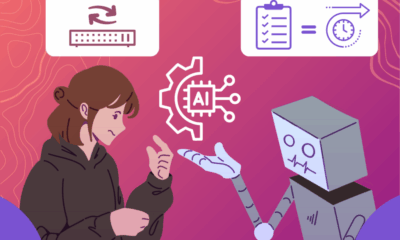MARKETING
3 Efficient Strategies to Create a Successful Work From Home Experience

Before 2020, companies used remote work as a perk to entice new employees and improve job satisfaction in a way that health benefits and paid leave do. As most companies embraced remote work to ensure business continuity and employee well-being, work from home (WFH) was the new normal by the end of 2020. The technology innovation has made work from home experiences superiors and employees have got accustomed to the emerging workplace environment.
Even as the companies plan to adopt hybrid work models as a permanent policy, there is still debate about how the workforce will remain remote. According to a future workforce report 2021, 67% of businesses reported that there were changes to long-term management practices to factor in new workplace realities. The report suggests that fully remote workers will represent 27.7% of the workforce, as one-fifth will be partially remote.
The employee convenience, along with time and cost savings, accelerated the remote work-from-home trend. There are two crucial factors driving the trend. The first is the advancement in technology that enables people to work from anywhere in the world, and the second is the increasing number of employees who value flexibility and work-life balance. In a survey, 74% of the workers have indicated that the option to work remotely would make them less likely to leave the company.
Even though the employees are as productive working remotely as in the physical office, the companies still have concerns about employee productivity and communication in a remote work-from-home environment. Remote employee productivity is the top-most concern of companies when their employees work from home. The companies face challenges such as how to measure productivity and which workforce productivity monitoring tools to implement for the same.
Companies can leverage three efficient strategies to create a successful work from home experience for their employees while ensuring peak workplace productivity.
1. Build a connected workplace
Traditionally, the term ‘digital workplace’ was used to refer collectively to word processors, emails, and internet applications. It has now evolved to represent a broader set of tools and technologies, which includes human resource (HR) systems, workflow management tools, and data analytic tools. Digital workplace platforms integrate multiple business applications and tools and enable employee access to information through a single platform. The platform enables employees to work seamlessly with their team and customers and enhances their experiences.
A digital workspace is an end-user computing platform that enables employees to work securely from anywhere, using any device. The digital workspace has evolved from a single computing device to a combination of devices such as laptops, desktops, tablets, and other mobile computing devices. Digital workspace varies for employees depending on the type of work they do.
A corporate intranet is a web-based application or a private network used by a company for internal communication and collaboration, knowledge dissemination, and employee development. Initially, the intranet was an information repository containing links to other resources. But with the evolution of the internet, the intranet, too, has evolved. It has become an engaging employee communication and collaboration platform across an organisation. As employees work remotely, the intranet has emerged as a digital hub that helps companies improve employee efficiency and productivity and develop organisational culture. Access to the intranet is restricted to only authorised employees.
Why is intranet important for a connected workplace?
Digital workspace and intranet are part of a larger digital workplace. All organisations have a digital workplace and workspace in some form, but they may or may not have an intranet. Remote work from home (WFH) requires employees to use a multitude of tools and platforms. Intranet offers frictionless access to multiple applications and tools through a single sign-in. It saves employees from remembering multiple user IDs and passwords, improving their productivity and experience. Intranet is a centralised knowledge repository that includes video tutorials, self-help guides, and online learning modules. All these resources make it easy and convenient for employees to work remotely.
Intranet helps to overcome the lack of personal physical interactions by facilitating online community building and binding people and teams into one cohesive unit. It leads to positive culture change in the organisation.
A digitally connected workplace is crucial for success in a remote work-from-home environment. A secure workspace and intranet are important elements of an integrated workplace and lead to better work from home experiences for employees.
2. Enhance collaboration and productivity
-
Remote work flexibility as the new job satisfaction metric
A digitally connected workplace enabled companies to quickly realign their workforce to the new reality of working from home when access to physical offices was restricted. They had to depend on tools and technologies to fulfil their professional responsibilities and client commitments. The evolution of cloud computing enhanced employees’ work from home experience as cloud-hosted tools and platforms enabled them to meet their professional obligations without any difficulty.
After a significant number of employees have worked from home for a considerable period, the flexibility of remote work has become a part of employee job satisfaction and a key requirement of employees for them to continue in their company or accept new job offers. As high as 82% of employees have indicated their interest to work remotely at least once a week. About 46% will look for another job if the remote work facility is not extended by their organisation.
-
Balance between employee expectation and organisational productivity
The companies are faced with the difficult task of balancing employees’ expectations of an engaging, flexible work environment and organisational productivity. They have to leverage a productivity tracker to evaluate remote employee productivity. Many factors make measuring productivity a challenging task for the organisation. However, it becomes easy for the organisation to track and evaluate its remote employee’s productivity with employee productivity tracking platforms.
-
Employee productivity tracking platform
A centralised employee productivity tracking platform enables real-time tracking of employee productivity by overseeing their system usage without invading their privacy. It provides insights into application usage, activity status, performance statistics and log-in hours. Besides productivity management, the tracking platform also ensures data security. The analytics module provides valuable insights into employee behaviour patterns and enables the company to detect employee burnout in the work-from-home environment.
The relevance of employee productivity tracking for call centres has assumed greater importance now that customers are increasingly dependent on online channels for their purchases. This makes it crucial for organisations to track and manage their call centre employee performance to meet end customers’ service expectations. Some relevant metrics for call centre employee productivity tracking are first call resolution, average handling time, customer satisfaction score, and average time in queue.
3. Use Digital Employee Experience (DEX) for higher productivity
-
DEX as the sum of employee experience across multiple workplace applications
The Digital Employee Experience (DEX) is the sum total of employee experiences while interacting with multiple business applications and digital tools at the workplace. The companies are faced with the challenging task of measuring up to employee expectations of frictionless digital experience, whether working from home or physical office.
Digital platforms are employees’ primary contact with the company, colleagues and clients in a remote work environment. Every digital touchpoint that an employee encounters during their work constitutes a DEX. It includes workforce and productivity tools, communication and collaboration platforms, learning management systems, and human resource (HR) systems. Digital employee experience is of equal priority for the organisation as customer experience, if not more.
-
Use of Intranet to enhance DEX
The intranet is key to enhancing the digital employee experience in a remote work environment. The single sign-in can offer an integrated and simplified experience across multiple applications and tools. Intranet enables business process automation that helps employees to complete tasks efficiently without any intervention. The intranet also enables the personalisation of content to meet employees’ needs and interests. The search functionality helps to generate relevant search results for employee queries, which improves productivity and engagement.
-
Enhanced DEX leads to happy and productive employees
Digital employee experience contributes to the overall employee experience. An enhanced DEX helps in creating happy employees, who are more productive. It is time for organisations to focus on an employee-centric approach to creating the next generation work environment.
As organisations continue to adapt and evolve in the new normal, it has become important to factor in digital employee experience as part of workplace strategy to create a productive work environment. With client interactions also shifting online, an enhanced DEX will enable and empower employees to extend a similar experience for digital client interactions.
Conclusion
Work from Home (WFH) is a new organisational reality that will continue to evolve, aided by technology innovations. Companies have to strike the right balance between their employees’ expectations of flexible remote work and organisational productivity. They need to invest in appropriate tools and technologies to facilitate an efficient work environment and employees’ well-being. A digitally connected workplace and employee productivity tracking software for hybrid workforce are essential components of an organisation’s remote work strategy. Such a strategy serves to elevate employee experience while enhancing organisational performance.
Source link



















You must be logged in to post a comment Login